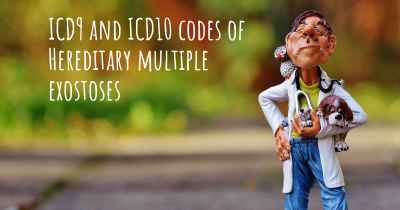What is the life expectancy of someone with Hereditary multiple exostoses?
Life expectancy of people with Hereditary multiple exostoses and recent progresses and researches in Hereditary multiple exostoses

Hereditary multiple exostoses (HME) is a rare genetic disorder characterized by the growth of multiple benign bone tumors called exostoses. While HME primarily affects the skeletal system, its impact on life expectancy varies widely depending on the severity and complications associated with the condition. The tumors can cause physical deformities, joint problems, and nerve compression, leading to pain and functional limitations. In some cases, exostoses may require surgical intervention. Although HME does not directly affect life expectancy, individuals with severe forms of the condition may experience reduced quality of life and potential complications. Regular medical monitoring, early intervention, and appropriate management can help mitigate the impact of HME on an individual's health and well-being.
Hereditary multiple exostoses (HME), also known as multiple osteochondromas, is a rare genetic disorder characterized by the development of multiple benign bone tumors called osteochondromas. These tumors typically grow near the growth plates of long bones, such as the femur, tibia, and humerus, but can also occur in other bones throughout the body.
Life expectancy for individuals with HME is generally considered to be normal. The condition itself does not directly affect life expectancy. However, the presence of osteochondromas can lead to various complications that may impact overall health and quality of life.
Complications associated with HME can vary widely depending on the number, size, and location of the osteochondromas. Some individuals may experience minimal symptoms and have a relatively unaffected life, while others may face more significant challenges.
Orthopedic complications are the most common issues related to HME. Osteochondromas can cause skeletal deformities, limb length discrepancies, joint limitations, and nerve impingements. These complications can lead to chronic pain, reduced mobility, and functional limitations. Regular monitoring and appropriate management by orthopedic specialists can help mitigate these complications and improve quality of life.
Malignant transformation is a rare but serious complication of HME. In some cases, osteochondromas can undergo malignant transformation into a form of bone cancer called chondrosarcoma. The risk of malignant transformation is estimated to be around 1-5% in individuals with HME. Regular surveillance with imaging studies is crucial to detect any signs of malignant transformation early, as prompt intervention can significantly improve outcomes.
Other potential complications associated with HME include vascular compression, spinal cord compression, and neurovascular deficits. These complications are relatively rare but can have significant consequences if they occur. Close monitoring and appropriate management by a multidisciplinary team of specialists, including orthopedic surgeons, radiologists, and neurosurgeons, are essential to address these potential complications.
Treatment for HME primarily focuses on managing symptoms, preventing complications, and improving quality of life. This may involve surgical removal of symptomatic or at-risk osteochondromas, physical therapy to improve mobility and strength, pain management strategies, and orthotic devices to support affected limbs.
Prognosis for individuals with HME largely depends on the severity of the condition, the presence of complications, and the effectiveness of management strategies. With appropriate medical care and regular monitoring, individuals with HME can lead fulfilling lives and have a normal life expectancy.
In conclusion, Hereditary multiple exostoses (HME) is a rare genetic disorder characterized by the development of multiple benign bone tumors. While HME itself does not directly impact life expectancy, the associated complications and potential risks of malignant transformation require careful monitoring and management. With appropriate medical care, individuals with HME can lead fulfilling lives and have a normal life expectancy.
Posted Nov 19, 2017 by Zahra 1950
Posted Dec 29, 2017 by J.K. 250








